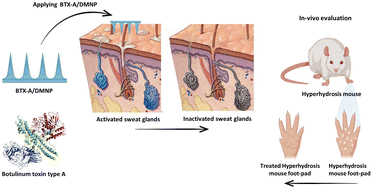Botulinum toxin A dissolving microneedles for hyperhidrosis treatment: design, formulation and in vivo evaluation†
Abstract
Multiple periodic injections of botulinum toxin A (BTX-A) are the standard treatment of hyperhidrosis which causes excessive sweating. However, BTX-A injections can create problems, including incorrect and painful injections, the risk of drug entry into the bloodstream, the need for medical expertise, and waste disposal problems. New drug delivery systems can substantially reduce these problems. Transdermal delivery is an effective alternative to conventional BTX-A injections. However, BTX-A's large molecular size and susceptibility to degradation complicate transdermal delivery. Dissolving microneedle patches (DMNPs) encapsulated with BTX-A (BTX-A/DMNPs) are a promising solution that can penetrate the dermis painlessly and provide localized translocation of BTX-A. In this study, using high-precision 3D laser lithography and subsequent molding, DMNPs were prepared based on a combination of biocompatible polyvinylpyrrolidone and hyaluronic acid polymers to deliver BTX-A with ultra-sharp needle tips of 1.5 ± 0.5 µm. Mechanical, morphological and histological assessments of the prepared DMNPs were performed to optimize their physicochemical properties. Furthermore, the BTX-A release and diffusion kinetics across the skin layers were investigated. A COMSOL simulation was conducted to study the diffusion process. The primary stability analysis reported significant stability for three months. Finally, the functionality of the BTX-A/DMNPs for the suppression of sweat glands was confirmed on the hyperhidrosis mouse footpad, which drastically reduced sweat gland activity. The results demonstrate that these engineered DMNPs can be an effective, painless, inexpensive alternative to hypodermic injections when treating hyperhidrosis.

- This article is part of the themed collection: Microneedles


 Please wait while we load your content...
Please wait while we load your content...